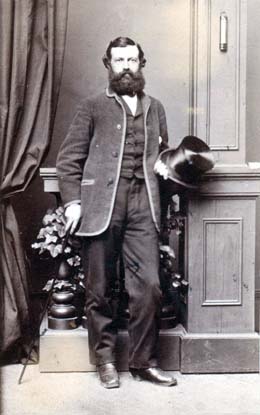In early February, 1890, Amos Bowman (1839-1894) of Anacortes builds the Skagit County town's first large sawmill. Lumber will be a major industry in the town for more than sixty years. By 1911, thirteen mills will operate along the town's Fidalgo Bay waterfront. Wood from the mills will be used for lumber, shingles, and boxes, with the pulp industry arriving in 1925. The industry will face decline by the mid-twentieth century and the city's last wood mill will close in 1992.
A Rush to Begin
On February 1, 1890, The Anacortes Progress reported that Amos Bowman had purchased a large sawmill in Seattle and hired an engineer and a team of bricklayers to construct the building in Ship Bay. An extremely rapid construction was expected, befitting the beginning of the Anacortes boom of 1890.
"As soon as the machinery arrives the work of construction will be commenced at once and is expected to have the mill in operation in one week from today. There are plenty of logs on hand and ready for the saw. The first lumber turned out will be used for sidewalks and streets, so that the streets will be in passable condition as soon as possible" (Progress).
The mill was expected to cut a respectable 29,000 feet per day, although the paper noted that the 40 horse engine would need an upgrade.
This was actually Bowman's second mill. His first attempt had been back in 1882 when he purchased a small saw to meet the very small local demand and to promote the young community. Although Amos Bowman would only live until 1894, he got out in front of an industry that would play a vital role in the coming decades. In fact, during the next few months, three more sawmills opened to fell timber for the town site.
Growth of an Industry
Many mills would come to Anacortes and the industry quickly diversified.
The Anacortes Co-Operative Shingle Company opened in 1892 and serves as an example of the challenges of the early years. The first mill on Fidalgo Bay, its tumultuous history reflects the early markets, changing hands several times in the first years until it was purchased by Robert P. Thomas. He continued to operate it as a shingle mill until 1900 before converting it to a saw mill.
The first mill to include a box factory roared to life in 1894 under the ownership of W. M. Rodgers. By 1906, three big mills produced large orders for the box industry. Further diversification came when Puget Sound Wood Products Company opened a factory in 1907 that produced charcoal, turpentine, and tar, among other products. Fidalgo Pulp Manufacturing Company opened in 1925 and continued until 1978. The Anacortes Veneer Mill began churning out plywood in 1939 -- the plywood mill would be the last wood-products plant to close, in 1992.
The best years of the lumber industry stretched from the turn of the century until the Great Depression. Some mills closed in the 1930s, but markets hit bottom in early 1933. Thereafter, several reopened, including the Woods mill in July of 1933. By 1940, defense contracts began coming in for the six mills remaining on Fidalgo Bay. When war came, the industry boomed again. Everyone had a job -- and pride in the city's reacquired prosperity.
The decade after World War II saw the gradual decline of the industry. A sharp decline came between 1952 and 1955 when all seven mills on Fidalgo Bay closed. By this time Shell Oil was building a refinery on March Point, leading the town in the new direction. The lumber mills did revive, with three mills operating on the Bay during the 1960s, but the pulp mills closed the following decade. Custom Plywood Corporation shuttered its windows in 1992 ending, at least for now, an industry that had helped shape the fortune and identity of Anacortes for generations.

